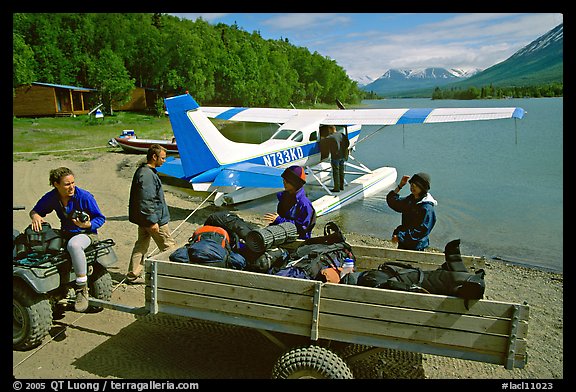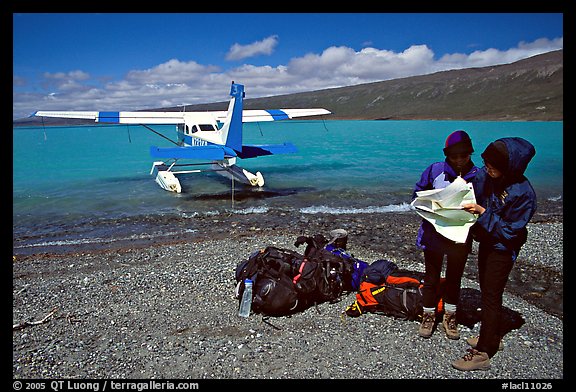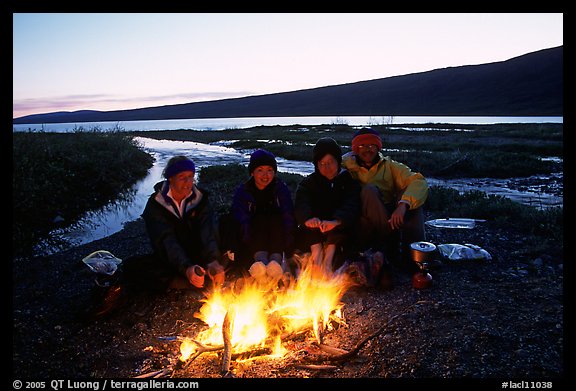Turquoise Lake to Twin Lakes Backpacking Trip
7 Comments
With long-distance travel somehow curtailed, it is time to reminisce about past experiences and long for the day when they will be possible again. Today marks the 56th anniversary of the Wilderness Act that provides the highest level of protection for America’s lands. One of my favorite wilderness journeys of the last two decades was the leisurely Turquoise Lake to Twin Lakes backpacking trip of June 2001 in the Jay S. Hammond Wilderness within Lake Clark National Park, Alaska. We experienced spectacular and wild country in a surprisingly easy trip that I can warmly recommend to any self-sufficient backpackers.

The first reason the trip was easy is that Lake Clark National Park is in Anchorage’s “backyard,” about an hour away by small plane, and you are dropped at your entry point into the wilderness by floatplane, a common practice in the Alaskan national parks, but generally not permitted in the national parks of the continental United States. For the background on Lake Clark National Park and more details on the logistics, check out this post focusing on Turquoise Lake. Five minutes from the drop-off point, our first camping spot at the mouth of Turquoise Lake, on its east end, was so beautiful that some people might enjoy just relaxing there for a couple of days.

The jagged peaks of the Telaquana Mountains rose above a wide gravel bar toward the east, catching the last light of the day. We explored the two valleys at the base of the Telaquana Mountains on the east of the lake via day hikes. The southern valley was wider and flatter, and we hiked along the rushing river until a distant waterfall came into view. The northern valley was steeper, and we ended following a moraine to a glacier. There were no trails, nor any trace of humanity, but also no way to get lost, as we just walked on the valley floor until deciding to turn around.



After three nights at the mouth of Turquoise Lake, we followed its south shore and set up camp for our fourth night near the west end of the lake, where a small peninsula jutting into the lake provided a view with excellent reflections of the mountains. Lake Turquoise is aptly named, for glacial silt colored the water a surreal, robin-egg blue that was a joy to see. At midday, because the sun penetrates the water, its color is more vivid than during the golden hours. I looked for a foreground of rocks that created a transition from the shore to the lake, keeping the lines horizontal to multiply the number of layers in the image. I then waited for the clouds to move in alignment with the mountains. A composition is most cohesive when the foreground is tied to the background in some way. I was particularly pleased that the four partly submerged rocks in the water mirrored the four clouds in the sky. I chose the image as the main photograph for Lake Clark National Park in Treasured Lands.



We left Turquoise Lake to head over the tundra, which in June was green and dotted with wildflowers. Between Turquoise Lakes and Twin Lakes, about 9 miles apart, open views stretched over vast expanses. As we saw a bear in the distance, we reassured ourselves that in the open landscape a close encounter was unlikely. Having gotten around the mountains, we could follow more or less a contour line to our next destination and enjoyed the freedom to walk on trail-less tundra where each step was soft underfoot. Although it was all wonderful, two landscape features stood out: a valley with a stream flowing and the arrival at Twin Lakes where we saw trees again. We enjoyed our fifth and last night in the wilderness near our pick up destination, the outlet stream at the northwest end of Twin Lakes. I photographed in the late afternoon and in the morning right a few steps from the tent, the opening and closing images of this post.



The second reason the trip was easy is that hiking took place on a high plateau. In Alaska, wet areas are full of tussocks which are ankle-twisting large knobs of soil that rise out of the mud and have grass growing out of them. Like potted plants without the pots, their tops are broader than their bottoms. Walking on that terrain entails hopping from one wobbly tussock to another. The plateau was high enough that we didn’t have to contend with those dreaded tussocks, and since it was above tree line, there was no bushwacking and open views made navigation straightforward. All the previous landscape photographs were captured on 5×7 film, and that made for a relatively heavy backpack although it was a short trip in moderate weather. I also carried a 35mm for the pictures of our group of four.










Wow! What a memorable trip too. The 5×7 film captures the colors incredibly well. I actually was not aware of Lake Clark NP until Treasured Lands came along, so now it’s on my radar and someday I’ll get up there to see it in person. Meanwhile, I’ll enjoy this posting from my couch. Thanks for sharing!
Thanks Michael. I am also enjoying it from the couch, as California is plagued by scorching temperatures in the 100s, and poor air quality from the wildfires…
Same problem in western Colorado, but record high temps today become record low temps tomorrow. We have heavy smoke from the California fires and not our local fires. Looks like we could get snow to help us with our fires or at least some rain to help the extreme drought conditions. Stay safe!
Love this, so much! And shot using 5×7, velvia or some other film? By the way, I absolutely love that first image, worthy of a print to hang on a wall!
Thanks Alen. I used only Velvia in the 1990s, but by the early 2000s tended to favor Astia for the better shadow detail, additional shutter speed, and more faithful color rendition.
Hey there! Lovely post. My friends and I are going to be doing a similar route soon from Twin Lakes to Turquoise. Do you think the connecting stream between the Twin Lakes is too much to cross on foot? We wanted to visit Dick’s Cabin and then traverse northwest around the lake, cross the stream, and continue on to Turquoise Lake. It seems like the rest of the journey is pretty straightforward but perhaps this river crossing will present some hurdles. Thoughts or insights? Thanks!
Sorry, I don’t know as I did not attempt to cross that stream. From the mouth of the lake, it appeared quite wide, though. I would ask the National Park Service rangers.